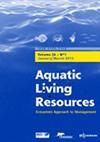孟加拉湾黄鳍金枪鱼(Thunnus albacares, Bonnaterre, 1788)的饮食组成和摄食习性
IF 1.9
4区 农林科学
Q3 FISHERIES
引用次数: 0
摘要
黄鳍金枪鱼(Thunnus albacares)是孟加拉湾重要的渔业资源之一,但该地区对其生态、饮食组成和摄食习性的了解有限。鉴于此,本研究将重点研究2019-2021年在孟加拉湾印度专属经济区进行的延绳钓探索性调查中捕获的黄鳍金枪鱼(YFT)的饮食组成和摄食习性。在42.0 ~ 171.0 cm叉长(FL)范围内共检测标本213份,其中28.2%为空标本,其余71.8%至少含有一种猎物。改进的Costello图形方法显示了广泛的猎物种类,其中少数猎物种类占主导地位,在孟加拉湾可以高密度地找到。由于这种顶级掠食者是一个多面手,这可能是事实。基于IRI(相对重要性指数)的聚类分析确定了两个大小组。具有较小(<80 cm FL)的YFT是一组。甲壳类动物是这一群体中最常被吃掉的猎物,其次是头足类动物和端骨动物。第二组由中等长度(81 ~ 120长度)和较大长度(>;120长度)两组组成,头足类为该组的主要猎物,占总摄取量的62.0%,其次是远骨类,占总摄取量的31.3%。头足类(Sthenoteuthis oualaniensis)是所有大小组的主要食物,其次是甲壳类(Charybdis smithii)和硬骨鱼(Cubiceps paucadiatus)。饲料宽度和空胃的发生与黄鳍金枪鱼的大小有显著相关。随着体型的增大,日粮宽度逐渐增大,空腹率逐渐下降。黄鳍金枪鱼的饮食在季节变化不大。然而,头足类动物在它们的饮食中占了53.5%。此外,空腹比例也有显著的季节变化,季风季节空腹比例最高(38.3%)。本文章由计算机程序翻译,如有差异,请以英文原文为准。
Diet composition and feeding habits of yellowfin tuna Thunnus albacares (Bonnaterre, 1788) from the Bay of Bengal
Though yellowfin tuna (Thunnus albacares) is one of the important fishery resources in the Bay of Bengal, knowledge on its ecology, diet composition and feeding habits are limited from this area. In view of that, present study focuses on the diet composition and feeding habits of yellowfin tuna (YFT) hooked during exploratory longline survey conducted in the Indian EEZ of the Bay of Bengal during 2019–2021. A total of 213 specimens in the length range of 42.0 to 171.0 cm fork length (FL) were examined, of which 28.2% were empty while the remaining 71.8% contained at least one prey item. The modified Costello graphical method shows a wide range of prey items, with a few prey species that are dominant and can be found in high densities in the Bay of Bengal. Due to the fact that this apex predator is a generalist feeder, this might be the case. Cluster analysis based on the %IRI (Index of relative importance) identified two size groups. YFT with smaller (<80 cm FL) is one group. Crustaceans was the most frequently eaten prey in that group followed by cephalopods and teleostea. The second group consists of two length groups medium (81–120 FL), and larger (>120 FL), Cephalopods were the dominant prey items of this group and accounts for 62.0% in %IRI followed by teleostea 31.3% of the diet. Cephalopods (Sthenoteuthis oualaniensis) were the primary food consumed in all the size groups, followed by crustaceans (Charybdis smithii) and Teleost fishes (Cubiceps pauciradiatus). The dietary breadth and the occurrence of empty stomachs were significantly related to size of the yellowfin tuna. With increasing body size, diet breadth gradually increased while the percentage of empty stomachs declined. The yellowfin tuna diet does not vary significantly during the seasons. However, cephalopods were found in 53.5% of the IRI in their diet. Furthermore, there were notable seasonal changes in the percentage of empty stomachs, with the highest percentage observed during the monsoon season (38.3%).
求助全文
通过发布文献求助,成功后即可免费获取论文全文。
去求助
来源期刊

Aquatic Living Resources
农林科学-海洋与淡水生物学
CiteScore
2.30
自引率
0.00%
发文量
10
审稿时长
>24 weeks
期刊介绍:
Aquatic Living Resources publishes original research papers, review articles and propective notes dealing with all exploited (i.e. fished or farmed) living resources in marine, brackish and freshwater environments.
Priority is given to ecosystem-based approaches to the study of fishery and aquaculture social-ecological systems, including biological, ecological, economic and social dimensions.
Research on the development of interdisciplinary methods and tools which can usefully support the design, implementation and evaluation of alternative management strategies for fisheries and/or aquaculture systems at different scales is particularly welcome by the journal. This includes the exploration of scenarios and strategies for the conservation of aquatic biodiversity and research relating to the development of integrated assessment approaches aimed at ensuring sustainable and high quality uses of aquatic living resources.
 求助内容:
求助内容: 应助结果提醒方式:
应助结果提醒方式:


